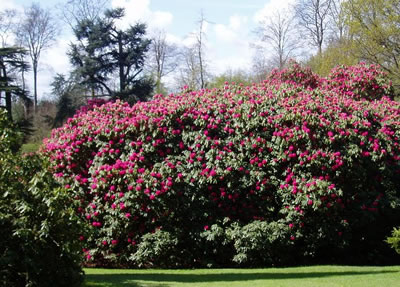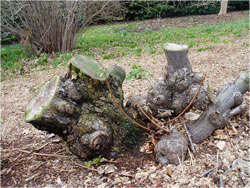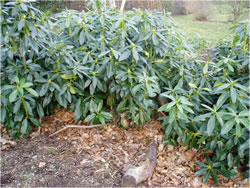Restoring overgrown rhododendrons
(Article by Alison Marsden of Gardening by Design -
Advice, coaching, design & teaching in West Kent & East Sussex)
Evergreen, large leaved Rhododendrons make a fantastic display in May and June but not all of us can let ours grow as large as this superb specimen at Riverhill Himalayan Gardens near Sevenoaks in Kent.

Along with Laurels, evergreen Rhododendrons must be the shrubs that I see most commonly having outgrown their allotted space in domestic gardens. These are both robust, long lived shrubs which, left to their own devices, develop a framework of thick ‘trunks’ supporting a huge dome of foliage. Rhododendrons continue to flower spectacularly without any human intervention and may be this is why they are so often not pruned at all until the house is sold and a new gardener wants the space freed up.
The good news is that as long as the plant is healthy and has not suffered climatic stress the previous year, particularly drought, then you can prune back drastically and more or less ‘start again’ from the old stump. This is because Rhododendrons (generally) carry dormant buds below the bark even in the oldest, mature wood and these buds will shoot if all the growth above them is removed. It is always worth taking a good look at the base of an overgrown specimen before you get the pruning saw out: if you see buds in the bark or small shoots emerging from the old stems as part of the normal growth pattern of the shrub, then it is a reasonable assumption that this will happen again to provide new growth after drastic pruning.
Full works pruning
The best time to prune evergreens in order to encourage new growth is early spring, after the hardest of the weather to avoid frost damage on the cut surfaces and before the growing season really gets underway. In Kent where I garden, this would be late March or early April. Of course you will be cutting off all the current year’s flowers but you will be rewarded by a flush of new shoots and all that empty space for other planting. Flowering will return over the next two seasons if you keep the shrub fed and watered whilst it recovers. A mulch of well rotted garden compost around the base directly after pruning will help here.
There is always a risk that an old shrub will not recover and you will be faced with removal and replacement. But unless it is rare and valuable, in which case you are ill advised to interfere at all without specialist advice, then nothing has been lost. It was too big and sprawling to remain unchecked so either you prune it back hard or you remove it altogether at the outset.
Part-pruning
With Rhododendrons the situation is often that they grow as wide as they are high – that dome shape mentioned at the start. In a small to medium sized garden, we are happy to have the height to provide privacy or screen a poor view but less happy to allow half the lawn to be shaded out by branches growing horizontally from the base. Here again drastic pruning comes into play, but this time just remove completely the lower branches growing at the front of the shrub and leave the vertical stems as they are. This typically removes 30-50% of the foliage so it is less risky than the ‘full works’ treatment and also exposes the architectural structure of the main stems usually hidden inside.
You can even train a late summer flowering clematis up the newly exposed branches to provide a second helping of flower colour in the same square meterage of your border.
|
|
Knarled old stump cut back drastically. The surrounding grass has been shaded out over a huge area indicating the original spread. |
Rhododendron regrowth already bearing flower buds for next spring. |
| |
|
Article very kindly provided by Alison Marsden of Gardening by Design - providing gardeners in West Kent & East Sussex with coaching, advice and design ideas since 2004 |
|




